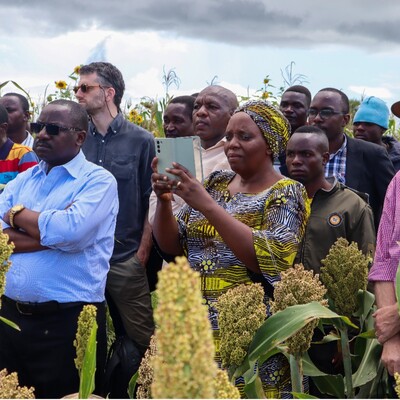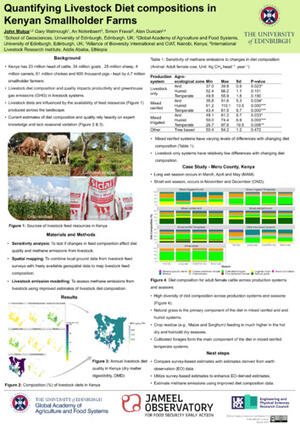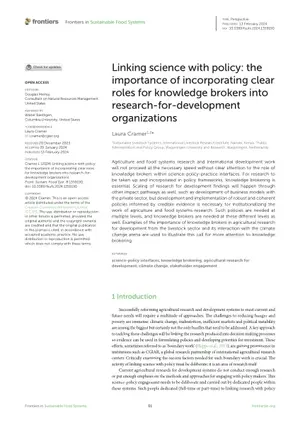
The Tanzanian livestock master plan: A conversation with Barry Shapiro
Barry Shapiro is a senior livestock development advisor at the International Livestock Research Institute (ILRI) and team leader for the development of livestock master plans in Ethiopia, Tanzania, and Rwanda. Working with the Tanzanian government, the team helped develop the Tanzanian livestock master plan, which the Tanzanian minister of livestock and fisheries, Luhaga Mpina, cited several times in his speech at his country’s first Livestock Expo and National Milk Week, held in Arusha, Tanzania, 30 May–1 Jun 2018. David Aronson spoke with Shapiro by telephone in late June 2018.
David: Let me begin by asking the most basic of questions. What is a master plan and why is it an important document to develop?

‘Master planner’ Barry Shapiro (photo credit: ILRI).
Barry: A master plan is a livestock sector investment plan. It has a five-year timetable, and it includes both investment analysis and a budget—both a financial and a human resource budget. This investment plan is meant to positively impact the economy of the country or state in which it’s carried out and to achieve the development objectives of the people and government. These include reducing poverty, increasing the revenue that the sector contributes to either state or national income, and improving food and nutrition security by including a strategy to increase animal-sourced food exports. And it’s supposed to have as broad and deep an impact as possible, and do so in a way that’s sustainable for the environment and helps prevent climate change.
David: That sounds complicated. What goes into the production of a master plan?
Barry: First of all, what we do is help the government identify its development objectives, to verbalize and prioritize those. Once we have that, then we look for the most reliable secondary sourced data. That means existing data—we don’t collect data to do this job. Then using what’s called the Livestock Sector Investment Policy Toolkit (LSIPT), we develop a dynamic herd model and an economic sector model on top of that. And we use those models to do a 15-year sector analysis, an analysis of the current situation of the sector and its potential for further development, modernization, transformation, and so on, over 15 years. This gives us a livestock sector strategy, what we call a livestock sector analysis. With that long-term vision of the sector, we develop an implementation plan for the next five years, which we call the livestock master plan, or the five-year livestock sector investment plan.
The bottom line: modernizing the livestock sector is not rocket science. It’s a combination of good investments and good business practices. It’s looking for win-wins between the processors and the farmers, where the farmers help the processors, and the processors help the farmers. And it works.
David: Let’s talk a little bit about the livestock sector in Tanzania specifically. In what ways is the situation there different from say, Kenya or Uganda or Ethiopia? What major challenges does the livestock sector in Tanzania face?
Barry: Well definitely the overwhelming challenge is feed. They have a large livestock population or national herd. They have a lot of land, as well, but there are competing demands on the land: there’s wildlife, there are crop farmers, and there are pastoralists. And the pastoralists are often in conflict with the wildlife and farmers—not generally violent conflict, as we might see in for example Nigeria, but legal and political conflict. There’s also an overabundance of regulations on the uses of the land. These have created a situation where, surprisingly, there are insufficient feed resources for modernizing the livestock sector, despite all of the land. So this is the challenge: How can we manage the existing resources and use them more productively, more efficiently, so that there is sufficient feed to complement modern production technologies? In the end, this is not just a feed and technology issue, but it’s also closely related to land policy.
David: Right. So there is a lot of politics as well?
Barry: Yes… but we try to analyse the situation, show what the consequences of different policies are, and how the situation might change if government policies change. We don’t prescribe policy, we recommend. Those recommendations feed into the political process but the Tanzanians basically work it out themselves.
David: Speaking of politics, let me play devil’s advocate for a minute. Why not just start over from scratch and build big factory farms on the outskirts of the major cities? Isn’t that what economic development ultimately really entails?
Barry: No, not at all. You know the great development success story of livestock in Africa recently has been the dairy sector in Kenya. This is a smallholder-based development success story, and it’s entirely possible to reproduce that success in Tanzania. In fact, it’s not just possible, but necessary. Because in Tanzania, as in many African countries, you have 70–80% of the population still living in rural areas. And their two main assets are their land and their livestock. Their livestock is their walking bank. It is their investment and their savings accounts, the asset they use to reproduce and grow their livelihood and the asset they rely on to maintain their livelihood under precarious conditions, such as climate variability and so on.
It’s also the case, perhaps counter-intuitively, that smallholder and large-scale commercial livestock development are not just compatible but complementary. And our analytical work shows this. It shows they really complement one another. So really it’s a win-win. It’s not one or the other. You can get good returns on investing in both, and that’s what we recommend in Tanzania and elsewhere.
David: So, it’s a larger complex subject. And the sector involves millions of people engaged in multiple and sometimes complicated activities—
Barry: However, it’s not rocket science. It is complicated, because there are so many factors involved. But it’s not rocket science, and it’s actually well-known how to modernize livestock production, even in smallholder production.
David: So what one or two recommendations would you give to each of the major sectors, the government, the private sector, the donors and the livestock keepers themselves?
Barry: For government we think they have to start with fact-based, evidence-based planning. This means good analytics, using the best available data. And this means solid financial analysis, because this is ultimately an investment, either by the government or the private sector. The private sector is more adept at doing this, but the government has to become more adept at it. We have identified the commodity value chains that could potentially have the biggest impact on poverty reduction, national income, food and nutritional security, and so on. And these objectives are usually much the same in most countries, with different degrees of emphasis. It could be also employment, including youth and women’s employment. And when you analyse the impact of investments on each of these objectives, then you can sort out what are the win-wins and what are the trade-offs. We present the data, we model projections, and we make these investment decisions as clear and transparent as possible, but ultimately it’s up to the government to make them.
With the private sector, we show them that for every dollar they invest, they’re going to make 20–30% returns, and we show that higher returns are possible if they outsource the production to smallholders. They’re going to gain 30–40% a year from every dollar they invest. And the investors we’re talking to are usually either large-scale producers or value addition processors of products, and for them, it’s a no-brainer. In Ethiopia, for example, we’ve had companies come to us not just to talk, but to invest. We now have several investment totaling USD200 million in meat processing, both for the domestic market and for export. We’ve seen a USD50 million investment in milk processing. And we’re seeing tens of millions of dollars going into chicken production. There’s no reason the same thing couldn’t be happening in Tanzania.
Read more about the Ethiopia livestock master plan
Download the Ethiopia livestock master plan: Roadmaps for growth and transformation
Ethiopian ‘livestock master plan’ to take 2.36 million households out of poverty
Animal breeding and genetics in the Ethiopia livestock master plan
Read more about the Tanzania livestock master plan
Download the Tanzania livestock master plan
Tanzania livestock master plan projects the creation of nearly two million jobs
Ethiopian ‘livestock master plan’ to take 2.36 million households out of poverty
















